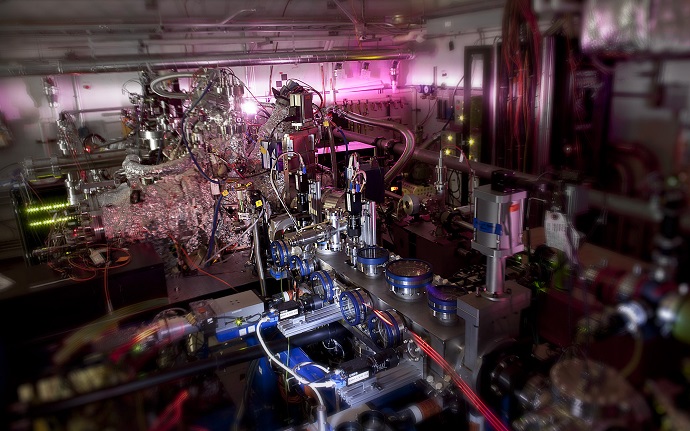July 9, 2014
An international team of scientists, including researchers from Lawrence Livermore National Laboratory (LLNL), has caught a central step of photosynthesis in action for the first time.
The team, led by Petra Fromme of Arizona State University, used the world's most powerful X-ray flashlight at the SLAC National Accelerator Laboratory to record still frames of a molecular complex called photosystem II as it splits water into hydrogen and oxygen, a process that releases oxygen into the atmosphere.
The researchers report their results today in the scientific journal Nature.
“What we’ve essentially done is to produce the first two frames of a molecular movie showing photosystem II, one of the most important biomolecules involved in photosynthesis in action,” said LLNL physicist Matthias Frank, the group leader for Advanced Diagnostics and Instrumentation in the Physical & Life Sciences directorate.
“This study is the first step toward our final goal of unraveling the secrets of water splitting and obtaining molecular movies of biomolecules,” explained Fromme, the paper’s senior author and a professor of chemistry and biochemistry at Arizona State.
The observations show with molecular resolution that photosystem II significantly changes shape during this process.
"A deeper understanding of photosynthesis could, for instance, aid the development of better solar cells and might advance the quest for biochemistry's holy grail, artificial photosynthesis," said Henry Chapman, of the Center for Free-Electron Laser Science (CFEL), a cooperation of Deutsches Elektronen-Synchrotron (DESY), the University of Hamburg and the German Max Planck Society.
"The water-splitting process is known to be divided into four steps," noted Chapman, who is a former LLNL employee. "But no one has actually seen these four steps in detail."
To observe photosystem II in action, the team grew tiny nano-crystals of the photosystem II complex of bacteria that employ photosynthesis, cyanobacteria called Thermosynechococcus elongatus. These crystals were illuminated with a visible laser to start the water-splitting process, which is driven by light. The researchers used double flashes to trigger the transition from the first stage to the third stage, as this transition was expected to show the largest dynamics.
With the short and intense flashes of SLAC's X-ray laser LCLS (Linac Coherent Light Source), the scientists could monitor how the molecular structure of the photosystem II complex changed during the process. The LCLS provides an exposure time of just 30 femtoseconds (quadrillionths of a second), short enough to freeze-frame the water splitting process at different stages.
In addition to Frank, the Livermore team included Stefan Hau-Riege, a physicist, and Mark Hunter, a postdoctoral fellow and physical chemist. They helped design the experiment and set up the optical laser for the pump-probe experiment that advanced photosystem II from the S1 dark state to the second excited state (S3) by exposing the PSII microcrystals to two carefully timed green light laser light flashes.
Hau-Riege is an expert on X-ray matter interactions and helped study and model potential sample damage during the ultra-short X-ray pulse. His and his colleagues’ studies have shown that the damage should be minimal for the conditions and samples studied here as long as the X-ray pulses are shorter than about 50 femtoseconds.
Hunter, a former graduate student of Fromme’s at Arizona State University, also helped with the PSII microcrystal sample preparation and characterization.
“This research allows for insight into the water-splitting function of photosystem II, one of the most important enzymes on the planet, by generating a few frames of the catalytic cycle of the enzymes,” Hunter said. “The research could provide deeper understanding of the mechanisms of photosynthesis, one of the most fundamental processes of life on the planet, and as such, is a very exciting initial development.”
Livermore’s work on the project was funded through the University of California Laboratory Fees Research Program and LLNL’s Laboratory Directed Research and Development Program, an internal funding mechanism.
"We were surprised by the large conformational changes we could witness," Fromme said. “Actually, the changes are so large that there is an overall structure change, which even changes the dimensions of the unit cell, the smallest building block in a crystal.”
The splitting of water during photosynthesis is a catalytic process, meaning that photosystem II enables the reaction without being used up. Catalysis plays a big role in many fields of chemistry.
"The technique we employed has a huge potential not only for photosynthesis, but for catalysis in general," Fromme emphasized. "If you would be able to observe all steps of a catalytic reaction, you would be able to optimize it."
"Our study also proves that molecular movies of biochemical processes are possible with an X-ray Free-Electron Laser," Chapman said.
To this end, a reaction is triggered many times and then monitored with precisely delayed X-ray flashes. This leads to a series of still frames that can be combined into a molecular movie.
"Such a movie could reveal the ultrafast dynamics of chemical reactions," Chapman explained. "But we still need to get to higher resolution first."
Founded in 1952, Lawrence Livermore National Laboratory (www.llnl.gov) provides solutions to our nation’s most important national security challenges through innovative science, engineering and technology. Lawrence Livermore National Laboratory is managed by Lawrence Livermore National Security, LLC for the U.S. Department of Energy's National Nuclear Security Administration.















